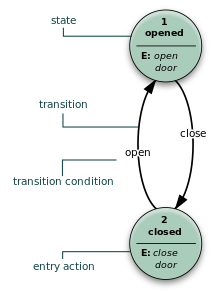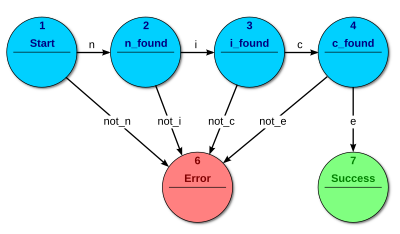A finite-state machine (FSM) or finite-state automaton (plural: automata), or simply a state machine, is a mathematical abstraction sometimes used to design digital logic or computer programs. It is a behavior model composed of a finite number of states, transitions between those states, and actions, similar to a flow graph in which one can inspect the way logic runs when certain conditions are met. It has finite internal memory, an input feature that reads symbols in a sequence, one at a time without going backward; and an output feature, which may be in the form of a user interface, once the model is implemented. The operation of an FSM begins from one of the states (called a start state), goes through transitions depending on input to different states and can end in any of those available, however only a certain set of states mark a successful flow of operation (called accept states).
Finite-state machines can solve a large number of problems, among which are electronic design automation, communication protocol design, parsing and other engineering applications. In biology and artificial intelligence research, state machines or hierarchies of state machines are sometimes used to describe neurological systems and in linguistics—to describe the grammars of natural languages.

A current state is determined by past states of the system. As such, it can be said to record information about the past, i.e., it reflects the input changes from the system start to the present moment. The number and names of the states typically depend on the different possible states of the memory, e.g. if the memory is three bits long, there are 8 possible states. A transition indicates a state change and is described by a condition that would need to be fulfilled to enable the transition. An action is a description of an activity that is to be performed at a given moment. There are several action types:
- Entry action
- which is performed when entering the state
- Exit action
- which is performed when exiting the state
- Input action
- which is performed depending on present state and input conditions
- Transition action
- which is performed when performing a certain transition
| Current state → Input ↓ | State A | State B | State C |
|---|---|---|---|
| Input X | ... | ... | ... |
| Input Y | ... | State C | ... |
| Input Z | ... | ... | ... |
In addition to their use in modeling reactive systems presented here, finite state automata are significant in many different areas, including electrical engineering, linguistics, computer science, philosophy, biology, mathematics, and logic. Finite state machines are a class of automata studied in automata theory and the theory of computation. In computer science, finite state machines are widely used in modeling of application behavior, design of hardware digital systems, software engineering, compilers, network protocols, and the study of computation and languages.
Acceptors and recognizers
Acceptors and recognizers (also sequence detectors) produce a binary output, saying either yes or no to answer whether the input is accepted by the machine or not. All states of the FSM are said to be either accepting or not accepting. At the time when all input is processed, if the current state is an accepting state, the input is accepted; otherwise it is rejected. As a rule the input are symbols (characters); actions are not used. The example in figure 2 shows a finite state machine which accepts the word "nice". In this FSM the only accepting state is number 7.
The machine can also be described as defining a language, which would contain every word accepted by the machine but none of the rejected ones; we say then that the language is accepted by the machine. By definition, the languages accepted by FSMs are the regular languages—that is, a language is regular if there is some FSM that accepts it.
[edit] Start state
The start state is usually shown drawn with an arrow "pointing at it from any where" (Sipser (2006) p. 34).[edit] Accept (or final) states
Accept states (also referred to as accepting or final states) are those at which the machine reports that the input string, as processed so far, is a member of the language it accepts. It is usually represented by a double circle.
An example of an accepting state appears in the diagram to the right: a deterministic finite automaton (DFA) that detects whether the binary input string contains an even number of 0's.
S1 (which is also the start state) indicates the state at which an even number of 0's has been input. S1 is therefore an accepting state. This machine will finish in an accept state, if the binary string contains an even number of 0's (including any binary string containing no 0's). Examples of strings accepted by this DFA are epsilon (the empty string), 1, 11, 11..., 00, 010, 1010, 10110, etc...
[edit] Transducers
Transducers generate output based on a given input and/or a state using actions. They are used for control applications and in the field of computational linguistics. Here two types are distinguished:- Moore machine
- The FSM uses only entry actions, i.e., output depends only on the state. The advantage of the Moore model is a simplification of the behaviour. Consider an elevator door. The state machine recognizes two commands: "command_open" and "command_close" which trigger state changes. The entry action (E:) in state "Opening" starts a motor opening the door, the entry action in state "Closing" starts a motor in the other direction closing the door. States "Opened" and "Closed" stop the motor when fully opened or closed. They signal to the outside world (e.g., to other state machines) the situation: "door is open" or "door is closed".
- Mealy machine
- The FSM uses only input actions, i.e., output depends on input and state. The use of a Mealy FSM leads often to a reduction of the number of states. The example in figure 4 shows a Mealy FSM implementing the same behaviour as in the Moore example (the behaviour depends on the implemented FSM execution model and will work, e.g., for virtual FSM but not for event driven FSM). There are two input actions (I:): "start motor to close the door if command_close arrives" and "start motor in the other direction to open the door if command_open arrives". The "opening" and "closing" intermediate states are not shown.
More details about the differences and usage of Moore and Mealy models, including an executable example, can be found in the external technical note "Moore or Mealy model?"
[edit] Determinism
A further distinction is between deterministic (DFA) and non-deterministic (NFA, GNFA) automata. In deterministic automata, every state has exactly one transition for each possible input. In non-deterministic automata, an input can lead to one, more than one or no transition for a given state. This distinction is relevant in practice, but not in theory, as there exists an algorithm (the powerset construction) which can transform any NFA into a more complex DFA with identical functionality.The FSM with only one state is called a combinatorial FSM and uses only input actions. This concept is useful in cases where a number of FSM are required to work together, and where it is convenient to consider a purely combinatorial part as a form of FSM to suit the design tools.The Unified Modeling Language has a very rich semantics and notation for describing state machines. UML state machines overcome the limitations of traditional finite state machines while retaining their main benefits. UML state machines introduce the new concepts of hierarchically nested states and orthogonal regions, while extending the notion of actions. UML state machines have the characteristics of both Mealy machines and Moore machines. They support actions that depend on both the state of the system and the triggering event, as in Mealy machines, as well as entry and exit actions, which are associated with states rather than transitions, as in Moore machines.



Walang komento:
Mag-post ng isang Komento